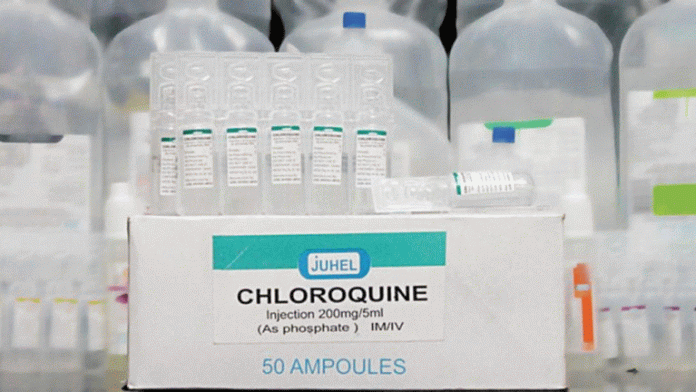
On March 16, SpaceX founder Elon Musk tweeted that the anti-malaria drug chloroquine was “maybe worth considering” as a treatment for COVID-19. He got 13,000 retweets. By March 19, President Donald Trump was touting chloroquine at a press conference. He even announced that the Food and Drug Administration had fast-tracked its approval for COVID-19. The FDA denied that this was the case a short time later.
While some of the hype has been fuelled by online media commentators outside the scientific literature, chloroquine’s potential in treating COVID-19 is gaining traction in the medical community.
The drug has a long track record in medicine, having been used since the 1940s as an antimalarial. The modern drug is made from the bark of the Cinchona plant, which was taken as an herbal remedy by indigenous Peruvians four centuries ago to treat fever. And there are some early indications it could work against SARS-CoV-2 infections.
For instance, a study in France published on March 20 in the International Journal of Antimicrobial Agents described the treatment of 42 patients hospitalized with COVID-19, 26 of whom received a version of chloroquine called hydroxychloroquine and 16 of whom received routine care. Of the 20 patients who took the antimalarial and completed the study, six also received azithromycin, an antibiotic. All six of these patients were free of SARS-CoV-2 by the fifth day post-treatment, while seven of 14 patients who took hydroxychloroquine alone were negative for the virus, and two of 16 control patients were no longer infected.
Small-scale experiments in which chloroquine has been given to COVID-19 patients in China and Australia have also shown encouraging results as far as shortening the course of the disease.
Larger clinical trials will be necessary to determine how effective the drug is. Researchers at the University of Minnesota have embarked on a study including 1,500 people to probe the drug’s effectiveness further in preventing the development of COVID-19 after people are exposed to SARS-CoV-2. The results could be available in a matter of weeks, Jakub Tolar, the dean of the University of Minnesota Medical School and vice president for clinical affairs, tells Reuters, and might indicate whether it’s worth launching a larger trial.
A small trial of 1,500 people would be a pragmatic step towards verifying the drug’s efficacy, says Jeremy Rossman, a virologist at the University of Kent, who praises the approach.
A number of other chloroquine experiments on humans are in the works. According to clinicaltrials.gov, researchers at the University of Oxford plan to give it as a prophylactic to 10,000 health care workers and others at high risk of contracting SARS-CoV-2. In Norway, doctors expect to begin administering the drug to hospitalized patients. And in Thailand, clinicians are preparing for a clinical trial comparing various combinations of antivirals, including chloroquine.
Chloroquine’s mechanism of action
If chloroquine is shown to be effective against SARS-CoV-2, it will not be via the same mechanism by which the drug functions as an antimalarial. That’s because malaria is caused not by a virus but by a microparasite of the Plasmodium genus. Chloroquine makes it toxic for the parasite to digest its host’s hemoglobin.
Chloroquine might have entirely different effects against a virus, such as, for example, disrupting the virus’s ability to enter a cell.
Nabil Seidah, a molecular biologist at the Montreal Clinical Research Institute (IRCM), and colleagues examined chloroquine’s effect on SARS-CoV back in 2005. Seidah is currently experimenting with drugs including chloroquine as potential SARS-CoV-2 treatments and using material sent to him by pharmaceutical firms.
 His 2005 study reported “strong antiviral effects” in animal cells in vitro. Seidah tells The Scientist that the mechanism by which chloroquine disrupts infection by a coronavirus remains unclear.
His 2005 study reported “strong antiviral effects” in animal cells in vitro. Seidah tells The Scientist that the mechanism by which chloroquine disrupts infection by a coronavirus remains unclear.
Chloroquine can raise the pH of endosomes, vesicles inside cells that are hijacked as points of entry by viruses. Endosomes have a slightly acidic pH, which helps facilitate this process. Seidah explains that chloroquine can raise endosomic pH slightly, which prevents fusion and stops the virus from entering the cell. Seidah says chloroquine may also block enzymes involved in the fusion between the virus and lung cells or stymie the viral replication process.
Whatever the mechanism, Seidah says, it’s likely a combination of drugs of some kind that will, ultimately, be needed to treat COVID-19.
“Chloroquine alone will not solve the problem,” he says.
Rossman says he would expect chloroquine to inhibit SARS-CoV-2 in the lab, based on what is known about its ability to raise endosomic pH. “But there’s often a huge gap between how it works in the lab cells and how it works in the body,” he says.
The drug is potentially dangerous when used at high doses or for prolonged periods. It can cause permanent blindness and even death. Rossman and Seidah agree that larger clinical trials are a must before chloroquine is considered safe and effective as a treatment for COVID-19.
*Written by Chris Baraniuk, a freelance science journalist based in Northern Ireland. Find him on Twitter at @chrisbaraniuk.





































